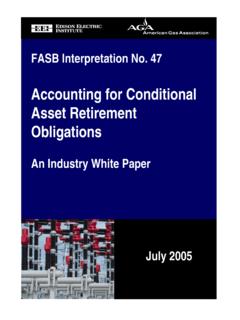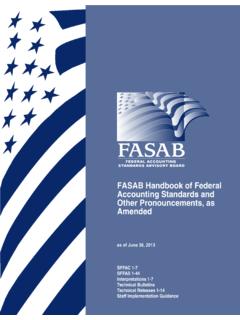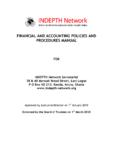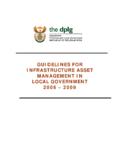Transcription of Asset Retirement Obligations Implementation Issues
1 Statement of Financial accounting standards No. 143, accounting for Asset Retirement Obligations Asset Retirement Obligations Implementation Issues October 2002 Fall 2002 1 Acknowledgements Dane A. Watson of TXU Business Services acted as the industry project manger representing the Edison Electric Institute (EEI) and was instrumental in coordinating the task force of individuals who created the enclosed industry position paper. Both EEI and The American Gas Association (AGA) would like to offer our gratitude and thanks to the individuals listed below who devoted extensive time and industry expertise in developing our positions. The individuals on the task force are, in most cases, active members of the EEI Property accounting & Valuation and AGA accounting Services Committees: Doug Allen The American Gas Association Daniel Blalock Southern Company Services, Inc.
2 Richard Clarke Southern California Edison Company Steve Cushman NICOR Leonard Delozier Baltimore Gas & Electric Company Michael Donahue Minnesota Power Peter (Matt) Gordon Duke Energy James Henderson American Electric Power Company Cathy Muszynski Xcel Energy Lisa Perkett Xcel Energy Alina Rocha PSEG Services Corporation Paul Stetz PSEG Energy Technologies Julia Valliere Edison Electric Institute Dane Watson TXU Business Services Copyright 2002 By the Edison Electric Institute and The American Gas Association Printed in the United
3 States of America All rights reserved. This paper, or parts thereof, may not be reproduced in any form without permission of the Edison Electric Institute or The American Gas Association. 2 Table of Contents Overview 3 Scope 3 Measurement 11 Calculation Process Overview 14 SFAS No. 143 Journal Entry accounting 22 Unregulated Operations 22 Regulated Operations 27 Financial Statement Disclosure 32 Record Keeping Issues for SFAS No.
4 143 34 Appendix A Multiple Year Cash Flows Appendix B Unregulated and Regulated Operations ARO Journal Entry Assumptions 3 Statement of Financial accounting standards No. 143 accounting For Asset Retirement Obligations Overview1 In June 2001, the Financial accounting standards Board (FASB) issued Statement of Financial accounting standards (SFAS) No. 143, accounting for Asset Retirement Obligations (ARO s). SFAS No. 143 changes the way companies recognize and measure legal Retirement Obligations that result from the acquisition, construction and normal operation of tangible long-lived assets. In general, companies will be required to recognize much sooner any legal liability associated with the future Retirement of tangible long-lived assets.
5 SFAS No. 143 is effective for fiscal years beginning after June 15, 2002 (January 1, 2003 for calendar year companies). Asset Retirement Obligations must be recognized as a liability and measured at fair value. The cost associated with the recognition of the Asset Retirement obligation is capitalized as part of the related Asset s book cost and is depreciated over the expected life of the Asset . The Asset Retirement obligation is initially recorded at fair value, so the increase in that liability causes accretion expense (similar to interest) to be recognized each period as an operating expense in the income statement.
6 SFAS No. 143 does not grandfather any current accounting for existing Obligations . Companies will convert to the new standard and recognize the cumulative effect of initially applying the statement as a change in accounting principle. The amount to be reported as a cumulative effect adjustment in the statement of operations is the difference between the amounts, if any, recognized in the statement of financial position prior to the application of SFAS No. 143 and the net amount that is recognized in the financial statements by applying the new Standard. Any Asset Retirement Obligations that are currently reported as part of accumulated depreciation will be reversed as part of the cumulative effect adjustment.
7 Scope The scope of SFAS No. 143 is set forth in paragraph 2 of the Statement: This Statement applies to legal Obligations associated with the Retirement of a tangible 1 The methods, processes, and procedures contained in this paper are intended to illustrate and provide examples for one or more analytical models by which certain Asset Retirement Obligations (ARO's) could be evaluated. This material is intended neither to exclude the validity of other models, nor to be an exhaustive and comprehensive presentation of all valid models. The models described in this paper may not be applicable to particular situations and are not necessarily recommended for the reader's specific application.
8 It is the conclusion of the authors that each entity assessing ARO's should consult with its auditor, accountants, and legal counsel. 4 long-lived Asset (emphasis added). The Obligations included within the scope of the standard are those associated with the Retirement of a long-lived Asset that result from the acquisition, construction, or the normal operation of a long-lived tangible Asset . An ARO liability should be recognized if it meets the definition of a liability in FASB Concepts Statement No. 6, Elements of Financial Statements. In assessing whether an ARO meets this definition, an entity should determine if: a) It has a present duty or responsibility to one or more other entities that entails settlement by probable future transfer or use of assets, b) It has little or no discretion to avoid a future transfer of use of assets, and c) An obligating event has already happened.
9 What does this mean and how does a company determine if a long-lived Asset is within this scope definition? Only assets that are defined as tangible and long-lived are included. There has been much discussion concerning what constitutes a tangible long-lived Asset . While there is no clear definition given, examples of tangible long-lived assets include items such as generation plants, mines, gas mains and compressor stations, substations, transformers, buildings, capacitors, lines, poles, streetlights and fee property. Examples of assets that are not tangible long-lived assets include software, organization costs, and goodwill.
10 A company must then determine if any legal Obligations exist that are associated with the Retirement of these long-lived assets. Retirement is defined as other-than-temporary removal of a long-lived Asset from service. It includes sale, abandonment, recycling, or disposal in some other manner. However, it does not include the temporary idling of a long-lived Asset . Identifying ARO s and measuring the liability is the most critical part in the adoption of SFAS No. 143. It is recommended that utilities form working teams and include representatives from legal, accounting , financial, operations and other business units as deemed necessary.





